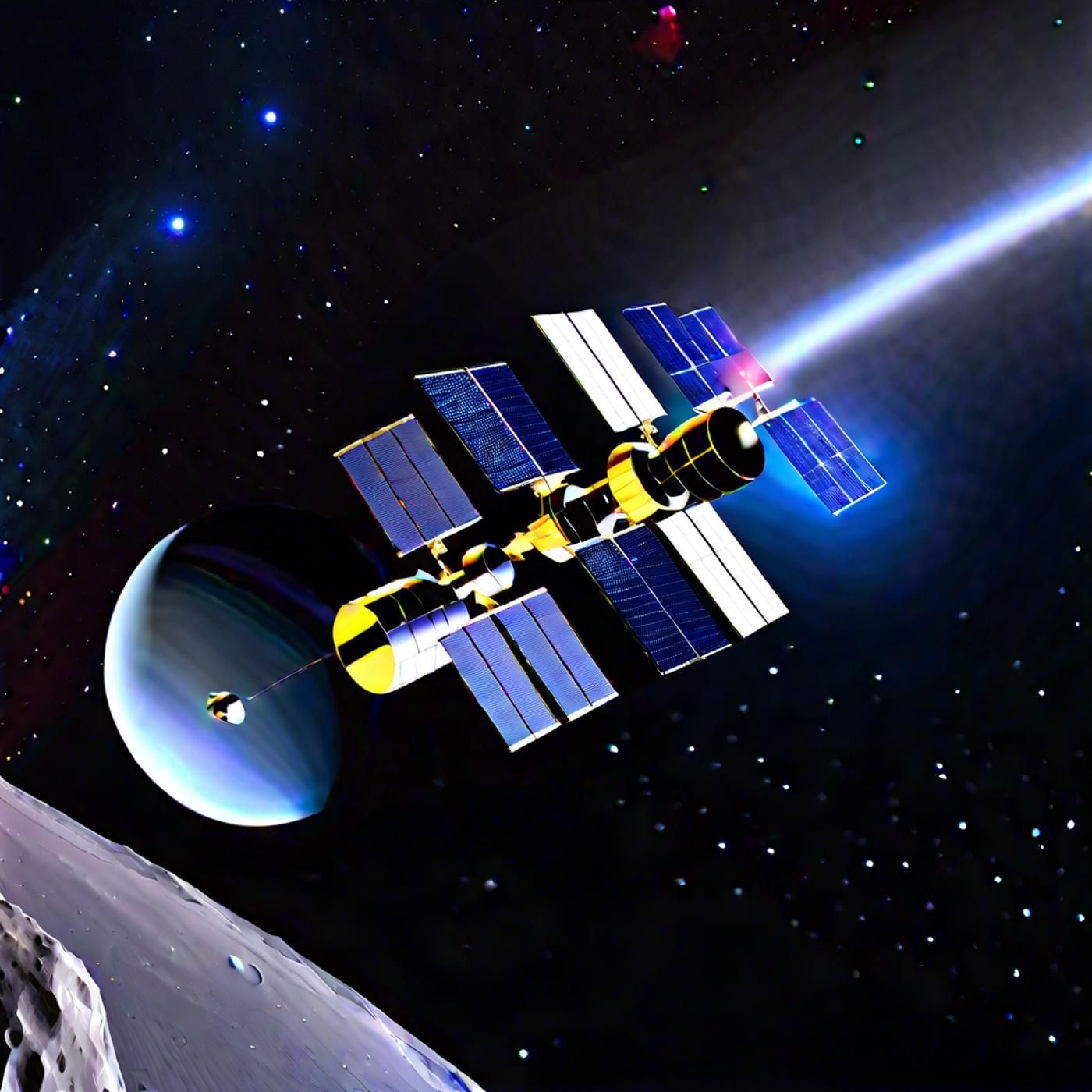S03E54: Sierra Space's Tenacity & Webb's Puffy Planet Puzzle: The Week in Space

Embark on an astronomical adventure with today's episode of Astronomy Daily - The Podcast, where your host, Anna, unpacks a cosmic array of space news and scientific revelations. Today's journey takes us from the Kennedy Space Center, where Sierra...
Embark on an astronomical adventure with today's episode of Astronomy Daily - The Podcast, where your host, Anna, unpacks a cosmic array of space news and scientific revelations. Today's journey takes us from the Kennedy Space Center, where Sierra Space's Dream Chaser Tenacity is poised to redefine cargo delivery to the ISS, to the flurry of global launches that underscore an unprecedented era of space exploration. We'll dissect a new NASA study that could revolutionize how we tackle the escalating issue of orbital debris. Plus, we dive into the enigmatic exoplanet WASP-107b, whose secrets are being unraveled by the James Webb Space Telescope, and discuss the concerning research from Nanjing University that Mars may be more vulnerable to asteroid impacts than Earth.
(00:00) This podcast features the latest in space and astronomy news
(01:15) This week features multiple significant launches, highlighting the relentless pace of space exploration
(03:46) Researchers using NASA's James Webb Space Telescope have unveiled why WASP 107 b is puffy
As we navigate these stories and more, remember to visit our website at astronomydaily.io for our episode back catalog, sign up for our free daily newsletter, and follow the latest space and astronomy news. For those who prefer YouTube, find us there and subscribe—the link is on our website and in the show notes. Join us as we gaze into the cosmos, seeking clarity in the night sky and marveling at the starry wonders above. Until our next cosmic rendezvous, this is Anna wishing you clear skies and starry nights.
Follow us on YouTube: https://www.youtube.com/@astrodailypod
Sponsor:
This episode is brought to you with the support of NordPass....the password manger (and major stress reliever) that you need in your life. Plus, it doesn't cost very much if you use our special link. For details visit www.bitesz.com/nordpass - thank you.
Become a supporter of this podcast: https://www.spreaker.com/podcast/astronomy-daily-the-podcast--5648921/support.
AI Transcript
This podcast features the latest in space and astronomy news
Anna: Welcome to Astronomy daily, your source for the latest in space and astronomy news. I'm your host, Anna, and today we'll be diving into a range of exciting topics. We'll explore NASA's latest preparations for the launch of Sierra space's innovative uncrewed space plane Dream chaser tenacity, which is set to deliver vital cargo to the International Space Station. In addition, we have a busy week ahead with numerous significant launches from around the globe, including SpaceX rocket Lab and China's ambitious missions. We'll also delve into an insightful new study from NASA on cost effective methods for mitigating the growing problem of orbital debris. And for those fascinated by exoplanets, you'll be intrigued by the latest findings about the mysteriously puffy gas giant exoplanet Wasp 107 b, as decoded by the James Webb Space Telescope. Lastly, we'll uncover new research from Nanjing University that reveals Mars faces a higher risk of asteroid impacts compared to Earth. Stay with us for these stories and more on today's episode of Astronomy Daily Execute audio, the Astronomy daily podcast.
This week features multiple significant launches, highlighting the relentless pace of space exploration
As part of NASA's efforts to expand commercial resupply in low Earth orbit, Sierra Space's uncrewed space plane dream chaser tenacity has arrived at Kennedy Space center. This cutting edge spacecraft is set to deliver 7800 pounds of cargo to the ISS aboard, AH, a United launch Alliance Vulcan rocket later this year, marking a significant step in commercial space missions. The Dream chaser, with its unique winged design, exemplifies innovation in space transportation, enabling it to transport cargo efficiently and land like an airplane on a Runway. Upon arrival, teams will conduct final testing and pre launch processing to ensure mission success. This venture signifies a prominent progression in NASA's collaboration with private enterprises to sustain and expand their presence in space. This week features multiple significant launches, making it an exciting period for space enthusiasts. China's Long March 2 D and Quizzhou eleven missions aim to add to their growing list of successful satellite deployments. On the other side of the globe, SpaceX is set for a busy schedule with the NRL 146 mission for the National Reconnaissance Office and two additional Starlink launches. Rocket Lab also joins the action with a double header, starting with the NASA pre fire mission. Additionally, Boeing's much anticipated Starliner crewed flight test has finally been rescheduled, projecting to lift off later in the week. Collectively, these launches not only highlight the relentless pace of space exploration, but also showcase SpaceX's impressive feat of surpassing 50 launches this year alone. NASA's M Office of Technology, Policy and Strategy has released a comprehensive report on cost effective methods for mitigating orbital debris. Utilizing an economic lens, the study provides new insight into actions ranging from shielding spacecraft to deorbiting defunct satellites. This analysis aims to address the growing problem in space sustainability by examining the risks posed by space debris, not just in terms of quantity, but in economic impact. The findings suggest that new, more cost effective methods are available for maintaining the safety of space operations, offering critical guidance for future space policy and technology development. By highlighting the economic benefits of these approaches, the report underscores the importance of integrating cost considerations into space debris mitigation strategies to ensure the sustainable use of outer space.
Researchers using NASA's James Webb Space Telescope have unveiled why WASP 107 b is puffy
Researchers using NASA's James Webb Space Telescope have unveiled why the gas giant exoplanet WASP 107 b is so puffy. Through detailed analysis, scientists discovered that the planet's atmosphere contains unexpectedly low levels of methane gas. This surprising finding indicates that the interior of WASP 107 b must be significantly hotter and its core much more massive than initially estimated by previous models. The planet's slightly elliptical orbit is believed to cause tidal heating, contributing to its inflated state by adding extra energy. These insights not only solve the mystery behind WASP 107 b's unusual characteristics, but also offer a broader understanding of the formation and properties of other low density exoplanets. Expanding our knowledge of planetary science, a new study from Nanjing University reveals that Mars is at a significantly higher risk of asteroid impacts compared to Earth. The research indicates there are approximately 17,000 potentially hazardous asteroids on a collision path with Mars, a figure that is two and a half to three times higher than the number for Earth. These asteroids are large enough to cause major impacts, posing a severe threat to future martian settlements. This finding underscores the urgent necessity for the development of advanced asteroid detection and deflection technologies to safeguard human life and infrastructure on Mars. The study also suggests that with the anticipated advancements in telescopic technology, our capability to predict and potentially observe these near miss events will improve, providing crucial data to further refine our mitigation strategies. Thank you for tuning into this episode of Astronomy Daily. Be sure to visit our website at astronomydaily IO for our episode back catalog. Sign up for our free daily newsletter and stay updated with the latest space and astronomy news via our constantly updating news feed. And if you like to get your podcasts on YouTube, please look us up and subscribe. The link is on our website and I'll leave it in the show notes as well. Until next time, I'm Anna wishing you clear skies and starry nights.
New to Astronomy Daily - The Podcast?
Here are some great episodes to start with.


















